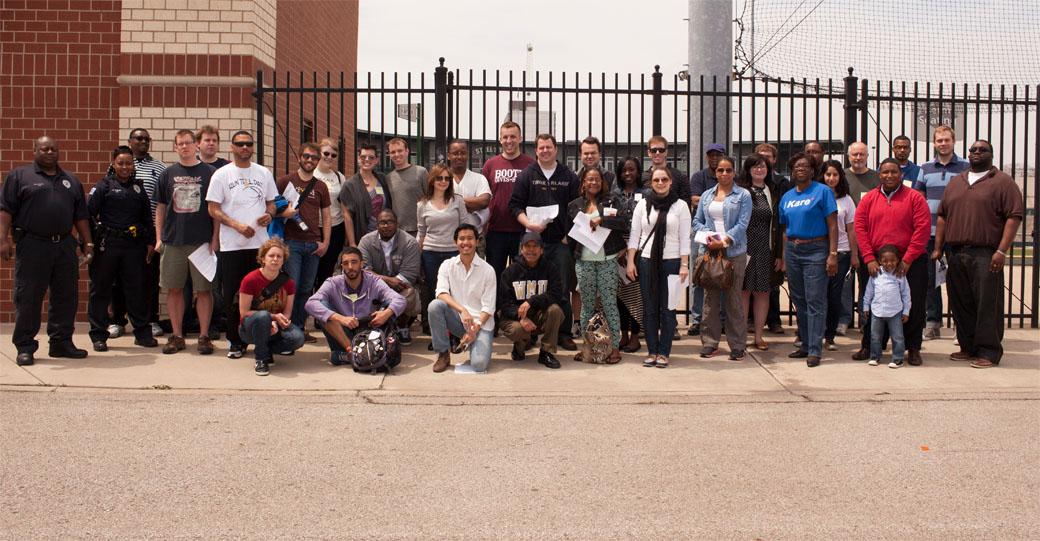
Abandoned buildings and the need for good data
Photo credit: The University of Chicago Harris School of Public Policy / Mayor Daley Fellowship
Jocelyn Hare is a graduate student at the Harris School of Public Policy Studies at the University of Chicago. Below, she writes about an effort to collect data in Gary, Ind., to aid property redevelopment. The survey used tools developed by LocalData, a Knight Foundation grantee.
Gary, Indiana
It was a daunting problem. Thousands of abandoned buildings. $10,000 to demolish a single home — $15,000 if it has a basement. Our budget for remediation? Approximately $0.
Built to house and support the workers of US Steel, Gary’s population peaked at 178,000 in 1960. Mechanization in the industry meant fewer and fewer steel jobs and, with other minimal job opportunities, the city’s population dropped to 80,000 by 2010. Driving down the city’s main street, boarded-up and burnt-out buildings line the avenue–evidence of Gary’s diminished population and limited resources.
How could a city with so few resources ameliorate one of its biggest and most costly problems? That was the question posed to students at the Harris School for Public Policy at the University of Chicago by former Chicago Mayor Richard M. Daley and Gary Mayor Karen Freeman-Wilson. They formed the Gary-Harris Initiative to help the city think through some of its most challenging problems.
Learning to solve problems like these was why I had enrolled as a policy student at Harris in the first place. But I’d be lying if I said it wasn’t daunting.
We didn’t have dollars, but we did have manpower and, importantly, a supportive mayor who encouraged creative solutions to old problems. We decided early on that our abandoned buildings strategies needed to be affordable, engaging to residents and actionable.
Enter LocalData
To come up with real solutions for Gary’s problem–and plan its redevelopment–we needed accurate data. Unfortunately, the best data we could get was out of date and said nothing about the condition of buildings.
I had the good fortune to meet Gregory Parrish of Data Driven Detroit (D3). D3 had completed the Detroit Residential Parcel Survey in 2009–essentially the same survey we hoped to perform in Gary. Greg told me they’d managed to survey the entire city of Detroit (more than 350,000 parcels) in two months–but getting the data from paper surveys into an electronic database took another two months.
Matt Hampel of LocalData had the next piece of the puzzle. LocalData offered to deploy their platform, a mobile survey app and data dashboard. It entirely eliminated the transcription time, and it gave us the tools to quickly visualize and map the data. LocalData also made it possible for volunteers and organizers to see results in real time, so we could cover any missed territory and avoid duplicated work.
The Gary Parcel Survey
LocalData helped to guide our team in crafting appropriate survey questions and launching an easy-to-use app that we could quickly demonstrate to volunteers and partners.
On the day of our pilot survey, our team of nine used LocalData to survey more than 800 parcels in Gary in less than two and a half hours.
Now we just needed more volunteers. The more people we could train on LocalData, the faster we’d be able to complete the entire city. We were ready to introduce the app to Mayor Freeman-Wilson.
In spring 2013 the mayor, city staff, Gary residents, University of Chicago students and Chicago volunteers gathered in Gary to venture on our first official data collection drive.
My biggest worry, teaching folks how to use the app, proved to be a nonissue. The design and functionality were simple and elegant. Being able to easily explain the app to less tech-inclined folks was critical to the survey’s success.
In the five days spent surveying, the teams have collected data on more than 16,000 parcels. Gary’s redevelopment department has already begun analyzing areas of need and developing plans to rehabilitate, deconstruct and demolish homes.
The Future of Public Policy
Collaboration is important in any policymaking process, especially when cities lack the resources to solve their own entrenched problems. The partnership with LocalData was a natural extension of the project. I strongly believe that these types of partnerships represent the best of what we can do with public policy–bringing human capital resources and policy expertise to bear on seemingly intractable problems and yielding high-impact, low-cost solutions.
New technologies, like those offered by LocalData, are key to helping cities break out of the status quo. We’ve always had the manpower. And now we have the means to direct this human capital to where it’s needed most.
Recent Content
-
Communitiesarticle ·
-
Communitiesarticle ·
-
Communitiesarticle ·


